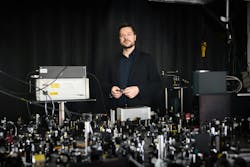On-off switching of resonances for nanophotonics was a long-standing industry challenge because optical resonators tend to remain coupled with light and can’t turn fully off, but Andreas Tittl, a professor of experimental physics at Ludwig Maximilians University of Munich in Germany, and colleagues at Monash University in Australia cracked it by creating an ultrafast on-off switch.
The new method controls coupling between nanoresonators and light to generate resonance within picoseconds or make it vanish again completely.
Tittl’s interest in nanophotonics comes from a fascination with how it can control the way light and matter interact at the nanoscale in new and innovative ways. “This offers exciting applications ranging from high-speed optical communications to quantum light generation,” he says. “But a major bottleneck was our inability to fully control light at this scale. Existing methods for tuning nanophotonic devices are more like using a dimmer switch: You can weaken the light signal or slightly shift its color, but you can't turn it completely on or off instantly and without energy loss.”
This inspired his team to find a way to overcome this fundamental limitation—with a goal of developing a true, ultrafast light switch with complete control over the interaction between light and matter (see video).
Metasurfaces/optical resonators
Metasurfaces—ultrathin surfaces covered in nanoscale structures designed to manipulate light—are at the heart of the team’s work. “We use these structures as optical resonators that can trap and amplify light of a specific color,” says Tittl. “Our key innovation is how we switch these resonators on and off. We introduced a concept where the metasurface unit cell is made of two tiny silicon rods deliberately designed to have different geometric shapes—physically asymmetric. Despite their different dimensions, we precisely engineered them so their optical responses perfectly cancel each other out.”
This means the structure is physically present, but it’s essentially invisible to the light because the switch is “OFF.” “This state, where we have optical balance despite geometric asymmetry, is what we call a ‘restored symmetry-protected bound state in the continuum’ (RSP-BIC),” Tittl says.
Temporal symmetry breaking
The team’s main innovation is “temporal symmetry breaking,” which is enabled by the two nanorods used for their work that are geometrically different so they absorb light with different efficiencies.
“We exploit this asymmetry by using an ultrafast laser pulse lasting only 200 femtoseconds that is selectively absorbed by just one of two rods,” explains Tittl. “This pulse temporarily changes the optical properties of one rod—instantly disrupting the delicate balance we created. Suddenly, the structure is no longer invisible; it couples strongly with light, and an optical resonance appears. The switch is ‘ON.’ When the material relaxes, the balance is restored and it turns ‘OFF’ again.”
The researchers used crystalline silicon for the nanoresonators (fabricated on a sapphire substrate). “Silicon responds very well to these optical pulses and is a foundational material within the photonics industry,” Tittl says.
A paradigm shift for active nanophotonics
What does this work mean for the field of nanophotonics and photonic integrated circuits (PICs), optical computers, and quantum comms? “We believe our ‘temporal symmetry breaking’ concept is a paradigm shift for active nanophotonics,” says Tittl. “Traditionally, researchers tuned resonators by altering the material, which often introduces unwanted energy loss. Our approach is fundamentally different because we are controlling the radiative coupling—the pathway between the resonator and the light.”
For PICs and optical computers, this opens the door for low-loss, high-speed optical switches that avoid the parasitic losses affecting current technologies—and will lead to much faster and more efficient data processing. “This level of precise control of light-matter interactions is critical for advancing quantum communication networks and even exploring exotic concepts like photonic time crystals,” says Tittl.
The coolest aspect of this work for Tittl is its core concept: Achieving a perfect optical balance within a system that’s structurally asymmetric, and then being able to disrupt this balance on demand at ultrafast timescales. “Our ‘aha’ moment was realizing that we could use this structural asymmetry to our advantage,” he says. “By making the rods different geometrically but identical optically, we obtained an entirely new mechanism for controlling light.”
Seeing the first experimental results from the time-resolved spectroscopy “was incredible,” Tittl says. “We watched in real time as a strong resonance appeared out of nothing within picoseconds when the laser pulse hit, and then vanished again. It was definitive proof that our approach of temporal symmetry breaking worked exactly as predicted, and confirmed we were controlling the light coupling without introducing significant losses.”
Proof of concept
The team faced two main challenges for this work. First, the fabrication required extreme precision. To achieve perfect optical cancellation despite the geometric asymmetry, the dimensions of the silicon nanorods must be exact. “Manufacturing our metasurfaces in a cleanroom was a significant undertaking,” Tittl points out.
The second challenge was measuring the ultrafast temporal behavior. “These switching events happen incredibly fast—on a subpicosecond timescale—and we needed a sophisticated time-resolved spectroscopy setup to capture these moments and prove our concept actually worked as predicted,” he adds.
This work is a fundamental proof of concept, “so the next steps will involve translating this technology toward practical applications and expanding its capabilities,” says Tittl. “While we used silicon, the principle is universal and we plan to apply it to other low-loss dielectric materials such as gallium arsenide. We’re also investigating even faster switching mechanisms based on nonlinear optical effects like the Kerr effect, which could push the switching times even shorter and expand its utility for ultrafast applications in next-generation optical devices.”
FURTHER READING
A. Aigner et al., Nature, 644, 896–902 (2025); https://doi.org/10.1038/s41586-025-09363-7.
About the Author
Sally Cole Johnson
Editor in Chief
Sally Cole Johnson, Laser Focus World’s editor in chief, is a science and technology journalist who specializes in physics and semiconductors.


